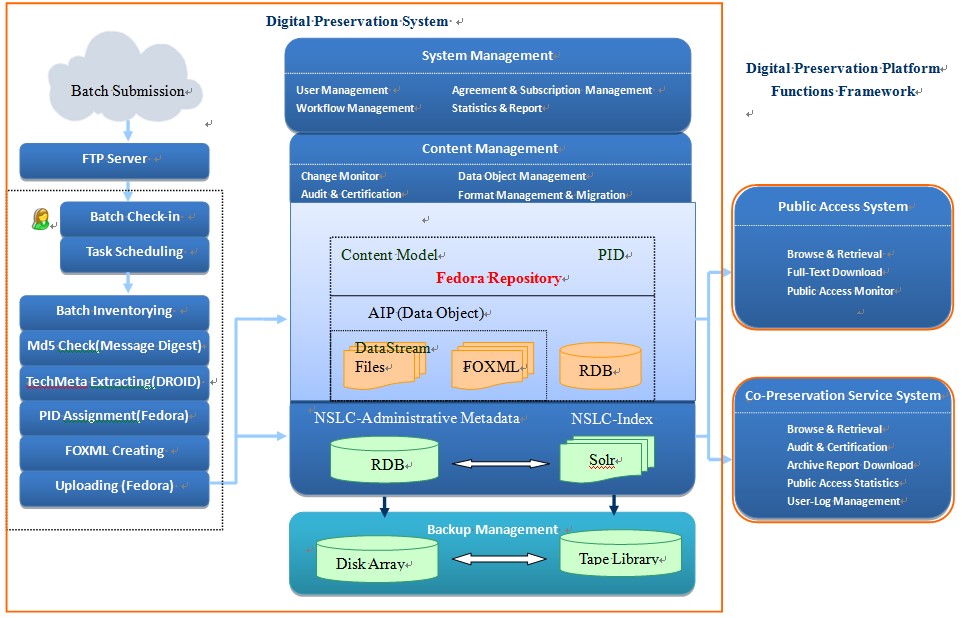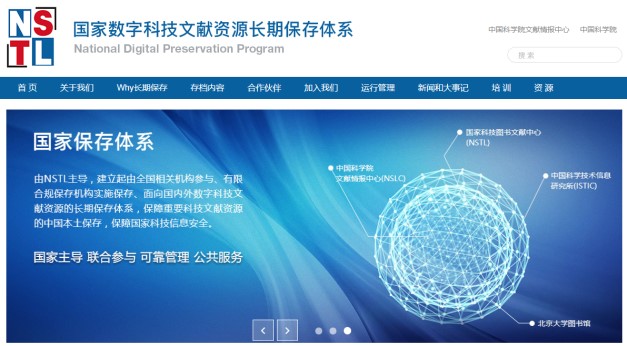Zhenxin Wu is Professor of the Information System Department and Deputy Director of the Digital Preservation Center of Chinese Academy of Sciences at the National Science Library in Beijing, China

与长期保存共同成长的十五年
长期保存对我而言,是我研究生涯的开始,之前我是一个图书馆系统程序员。2003年,张晓林教授找到我,希望我能参与斯坦福大学图书馆的一个项目协助做些事情,也就是日后很成功的LOCKSS项目。出于对这所著名大学的敬仰,我立刻就答应下来。从配合LOCKSS项目在中国北京建立一个测试节点开始,我逐步了解了数字资源长期保存的内涵,以及这项工作的重要意义,并产生了浓厚的兴趣。2004年,在北京作为工作人员参加组织了第一届数字资源长期保存国际会议(iPRES),目前iPRES已成为长期保存领域最有影响力国际会议。2005年Neil Beagrie先生介绍我到英国数字保管中心(DCC)作高级访问学者,在爱丁堡,我学习到很多新东西,也看到很多新思想的碰撞,结识了很多长期保存领域的专家。
回到北京后,在中国科学院的资助下,我开始从事电子出版物的长期保存研究和试验,对文件格式管理、fixity check,起源信息管理,数据迁移,以及可信赖审计与认证等进行了深入的研究,与团队一起开发了基于Fedora的电子期刊存档试验系统,并致力国家层面的宣传呼吁。
图1.电子期刊存档试验系统功能框架

终于在2015年,NSTL建立了国家数字科技文献资源长期保存体系项目,开始从国家层面,联合众多机构一起推动数字资源的长期保存。
随着大数据时代的来临,数字资源的保存危机越发严峻,数字资源的长期保存实际上就是守护人类文明成果,从这个意义上,越发感觉自己工作的重要性。”不忘初心,坚守使命”,保存管理数字资源,这也是图书馆员对自己职责的坚守,希望自己能为此作更多的事情。
图2. 国家数字科技文献资源长期保存体系网站
 For me, digital preservation marks the beginning of my research career. Before that, I was a programmer. In 2003, I met Professor Xiaolin Zhang and was invited to test some software at Stanford University Library. I could not turn down an opportunity to work with this famous university. I immediately agreed to participate in their project, which turned out to be the very successful LOCKSS project. I set up a server for the LOCKSS project to test LOCKSS software in Beijing, China. I gradually learned the meaning and the significance of digital preservation, and my interest in the subject grew stronger.
For me, digital preservation marks the beginning of my research career. Before that, I was a programmer. In 2003, I met Professor Xiaolin Zhang and was invited to test some software at Stanford University Library. I could not turn down an opportunity to work with this famous university. I immediately agreed to participate in their project, which turned out to be the very successful LOCKSS project. I set up a server for the LOCKSS project to test LOCKSS software in Beijing, China. I gradually learned the meaning and the significance of digital preservation, and my interest in the subject grew stronger.
In 2004, the first International Conference on Digital Preservation (iPRES)was organized in Beijing and I was a member of the conference group.
In 2005, Mr. Neil Beagrie introduced me as a senior visiting scholar at DCC in the UK. In this newly formed institute, I learned many new things and many ideas, and met many excellent people.
After returning to Beijing, with the funding of the Chinese Academy of Sciences, I began to do some research on electronic publications archiving, especially focusing on file format management, fixity checking, provenance information management, data migration, trusted audit and certification. I developed a digital preservation system based on fedora repository with our small team. At the national level, our team worked hard to appeal and advocate for digital preservation.
Fig 1. Function Framework of Digital Preservation System
 Finally, in 2015, National Science and Technology Library set up the National Digital Preservation Program which aims to archive digital science and technology literature resources. It's a good opportunity for us to work alongside many institutes and promote digital preservation in China.
Finally, in 2015, National Science and Technology Library set up the National Digital Preservation Program which aims to archive digital science and technology literature resources. It's a good opportunity for us to work alongside many institutes and promote digital preservation in China.
In the era of big data, the crisis of preservation of digital resources becomes more and more serious. Digital preservation, in the long run, it is actually guarding the achievements of human civilization. In this sense, it becomes more and more important.
“Remain true to our original aspiration and keep our mission firmly in mind: ” Digital preservation is our duty, and I hope that I can contribute more to this mission.
Fig 2. National Digital Preservation Program

Comments